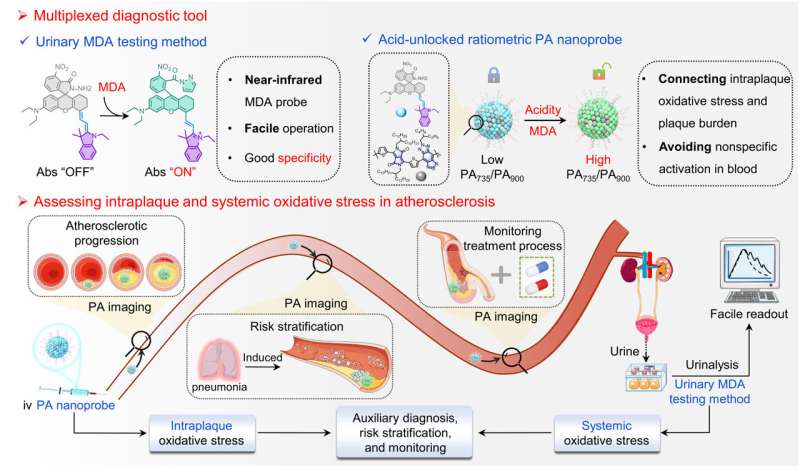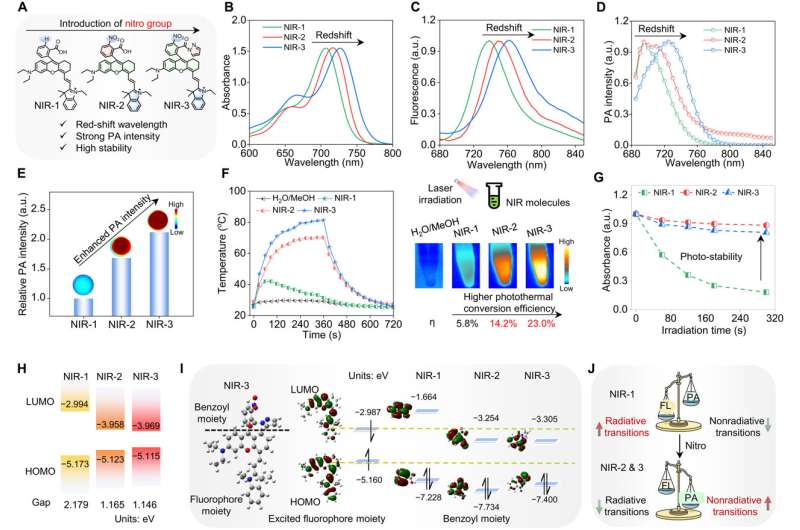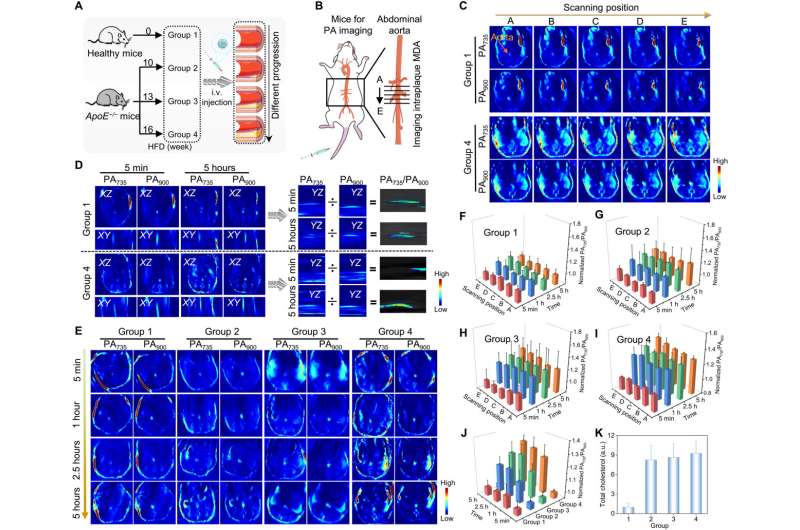October 23, 2023 feature
This article has been reviewed according to Science X's editorial process and policies. Editors have highlighted the following attributes while ensuring the content's credibility:
fact-checked
peer-reviewed publication
trusted source
proofread
Diagnosing atherosclerosis with an oxidative stress biomarker triggered multiplexed instrument

Oxidative stress is fundamental to the development of diverse pathological conditions including atherosclerosis. However, the effect of oxidative stress on atherosclerosis remains to be known.
In a recent report in Science Advances, Yuan Ma and a team of scientists in chemistry, cardiology and medicine at the Hunan University, China, developed a multiplexed diagnostic instrument with photoacoustic imaging and urinalysis to determine intraplaque and urinary malondialdehyde (MDA) as well recognized end-products of oxidative stress.
The team conducted molecular design to develop the first, near-infrared malondialdehyde-responsive molecule (abbreviated MRM). Using a photoacoustic nanoprobe, the team reported intraplaque malondialdehyde as a measure reflecting the plaque burden. This MRM molecule detected urinary malondialdehyde with excellent specificity.
The outcomes showed a significant difference in urinary MDA between healthy adults and atherosclerotic patients. The multiplexed diagnostic instrument can detect both intraplaque and systemic oxidative stress levels during atherosclerotic plaque progression and drug treatment in atherosclerotic mice as a promising auxiliary diagnosis measure.
The pathology of atherosclerosis and measuring it via oxidative stress in the clinic
Cardiovascular and cerebrovascular diseases are a primary cause of morbidity and mortality worldwide, and atherosclerosis plays a significant role at all stages.
The formation of plaque is a hallmark of atherosclerosis in chronic progressive lesions, alongside an unpredictability of plaque rupture contributing to severe cardiovascular and cerebrovascular events. As a result, evaluating plaque characteristics is significant to reduce morbidity. Nevertheless, the accurate prediction of plaque stage and location remains challenging to determine the noninvasive and reliable methods underlying high-risk plaques.
Oxidative stress is a significant biomarker of atherosclerosis at present, induced by excess reactive oxygen species. Chronic and acute inflammation of vascular walls can also similarly increase oxidative stress to contribute towards the development of atherosclerosis.

A photoacoustic nanoprobe from atherosclerotic mice to clinical use
Elevated levels of intraplaque oxidative stress can cause plaque vulnerability. As a result, the process of evaluating intraplaque oxidative stress can assist biologists and clinicians to identify plaque. Since traditional medical imaging methods are limiting to assess intraplaque and oxidative stress in atherosclerosis, Ma and colleagues sought to introduce a reliable instrument in clinic practice.
To accomplish this, they recognized malondialdehyde (MDA)—the product of lipid peroxidation as an ideal oxidative stress biomarker due to its sufficient stability. The team designed an MDA-responsive molecule (MRM) as a multiplexed diagnostic instrument.
The method conferred two functions—photoacoustic imaging and urinary malondialdehyde testing. The team used the photoacoustic nanoprobe in atherosclerotic mice to demonstrate its reliability in detecting oxidative stress and plaque characteristics in an atherosclerotic mouse model, with potential for auxiliary diagnostics and risk assay of atherosclerosis in clinical use.
Design, properties, and theoretical calculation of near-infrared molecule
Photoacoustic imaging agents are fundamental to improve the sensitivity of detection and to develop activatable probes. The team optimized the available photoacoustic agents for their medical imaging applications by introducing nitro groups to hemocyanin fluorescent molecules to improve the weak photoacoustic signal and photobleaching property of the fluorophore with near-infrared absorption and fluorescence emission.
Thereafter, the team measured the photothermal conversion capability of near infrared 1-to-3 in direct relation to photoacoustic intensity. To indicate improved photostability by introducing the nitro group, which inhibited the radiative transition process.

Design and response of malondialdehyde-responsive molecules
Since existing MDA probes exhibit short-wavelength fluorescence emission that leads to reduced tissue penetration, high background interference and a lower signal-to-noise ratio, Ma and the team used near-infrared-2 as the photoacoustic scaffold with near-infrared absorption and excellent photoacoustic properties. They also designed MDA-responsive molecule coupling hydrazine with benzoic acid to ultimately 'turn-on' absorption, fluorescence, and the photoacoustic signal.
The scientists showed how the introduction of the nitro group greatly improved the response of MDA-responsive molecules to malondialdehyde under acidic conditions. The outcomes highlighted the sensitivity of the malondialdehyde molecule to detect MDA in weak acidic conditions. The researchers optimized urinary MDA testing methods as one of the indicators of systemic oxidative stress to gain insights on atherosclerotic progression.
Testing urinary malondialdehyde levels
While urinary malondialdehyde (MDA) can be detected with the commercial kit where thiobarbituric acid reacts with the compound to form TBA-MDA, this can interfere with the accurate detection of urinary malondialdehyde. The team therefore developed a more specific testing method with malondialdehyde-responsive molecule to accurately determine the constituent of interest, without interference from external analytes.
Since malondialdehyde already exists in blood, the current probe can be activated in blood before it reaches the plaques to result in a false imaging signal. To prevent this, the team designed an acid-unlocked ratiometric photoacoustic nanoprobe. In its mechanism of action, the photoacoustic nanoprobe can be coactivated by acidity and the presence of malondialdehyde within the plaque, while the nanoprobe silently circulates blood due to the neutral pH of blood.
The scientists conducted reliable analysis of plaque characteristics ex vivo. Elevated levels of oxidative stress within the plaques can lead to local proteolysis, plaque rupture, and thrombosis formation in atherosclerotic arteries, to trigger cardiovascular events. It is important to study the generation of malondialdehyde as an endpoint since it is a biomarker of reactive oxygen-species driven elevated oxidative stress during atherosclerosis. The work confirmed the reliability of the photoacoustic nanoprobe to establish a bridge between intraplaque oxidative stress and plaque burden.
![Detection of urinary MDA in mice and humans. (A) Schematic procedures of urinary MDA testing method for mice and humans. (B) Urinary MDA for healthy and atherosclerotic mice. For the box-plot elements, the center line indicated the median line, and the box limits were from upper and lower quartiles. (C) Receiver operating characteristic (ROC) curve was constructed on the basis of urinary MDA between healthy and atherosclerotic mice [area under the curve (AUC) = 0.803]. (D) Scheme for stratification of healthy (n = 8) and atherosclerotic mice (n = 8). (E) Stratification based on urinary MDA for healthy and atherosclerotic mice in a blind study. The black line indicated the mean of urinary MDA in healthy mice from (B), the blue lines indicated the means ± SD of urinary MDA in healthy mice, and the red lines indicated the means + 2 or 3 SD of urinary MDA in healthy mice. The gray circles indicated the misclassified results after revealing the identity of the mice. (F) Urinary MDA for healthy adults (n = 265 independent individuals), atherosclerotic patients (n = 374, independent individuals), and patients with myocardial infarction (n = 76 independent individuals). (G) ROC curve was constructed on the basis of urinary MDA for healthy adults and patients with myocardial infarction (AUC = 0.903). Credit: Science Advances, doi: 10.1126/sciadv.adh1037 Oxidative stress biomarker triggered multiplexed instrument to diagnose atherosclerosis](https://scx1.b-cdn.net/csz/news/800a/2023/oxidative-stress-bioma-3.jpg)
Imaging atherosclerotic progression in mice
Atherosclerosis is a slow and silent process characterized by chronic arterial inflammation, offering opportunities for diagnosis prior to an adverse cardiovascular event. However traditional medical imaging still only facilitates the detection of advanced atherosclerotic plaque.
Ma and the team therefore used photoacoustic nanoprobes to identify plaque in living mice to highlight reliable ratiometric signals of elevated intraplaque malondialdehyde in diverse groups of atherosclerosis. The researchers then monitored intraplaque malondialdehyde and urinary malondialdehyde in mice with atherosclerosis and pneumonia complications, followed by the noninvasive monitoring of intraplaque and urinary malondialdehyde levels during drug treatment to investigate precision medicine of atherosclerosis for anti-inflammatory therapy.
The preclinical work led to its clinical translation. The team subsequently detected urinary malondialdehyde in mice and humans to examine the atherosclerotic biomarker excreted in urine. The measurement of urinary MDA indicated systemic oxidative stress levels for an auxiliary diagnosis of atherosclerosis in the early stage.
Outlook
In this way, Yuan Ma and colleagues reported a noninvasively multiplexed diagnostic tool to reliably identify intraplaque and urinary MDA levels to determine localized and systemic oxidative stress during atherosclerosis.
MDA is a commonly used biomarker to determine oxidative stress levels during inflammatory diseases, although it might have limits of detection with age, physical activity, diet, and other risk factors. The team propose additional experiments to develop reliable diagnostic tools to diagnose disease.
More information: Yuan Ma et al, Oxidative stress biomarker triggered multiplexed tool for auxiliary diagnosis of atherosclerosis, Science Advances (2023). DOI: 10.1126/sciadv.adh1037
Peter Libby, The changing landscape of atherosclerosis, Nature (2021). DOI: 10.1038/s41586-021-03392-8
© 2023 Science X Network




















